|
Descriptions: |
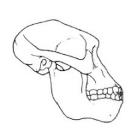 Sometime
around four to five million years ago, the gracile (lightly built) Australopithecine
Australopithecus afarensis evolved. This species, known to many
people from the individual named "Lucy", is generally considered to be
one of our earliest hominid relatives. Bipedally adapted, A. afarensis
stood one to 1.5m and had a cranial capacity of 400-500ml. Individuals
were lightly built with some ape-like features such as curved fingers
and toes and long arms relative to the length of the legs. Features included
a low, flat forehead, projecting face, prominent browridges, and relatively
large incisors and canines. Sometime
around four to five million years ago, the gracile (lightly built) Australopithecine
Australopithecus afarensis evolved. This species, known to many
people from the individual named "Lucy", is generally considered to be
one of our earliest hominid relatives. Bipedally adapted, A. afarensis
stood one to 1.5m and had a cranial capacity of 400-500ml. Individuals
were lightly built with some ape-like features such as curved fingers
and toes and long arms relative to the length of the legs. Features included
a low, flat forehead, projecting face, prominent browridges, and relatively
large incisors and canines. |
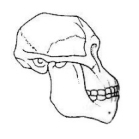 Another
gracile Australopithecine, A. africanus, evolved sometime around
three million years ago. A. africanus is also considered to be
an early human relative although there is debate as to whether the species
is in our direct lineage, ancestral to the robust (ruggedly built) Australopithecines,
or a common ancestor to both. A. africanus shares many characteristics
with A. afarensis including a light build and relatively long arms.
Individuals stood 1.1 to 1.4m and had a cranial capacity of 400 to 500ml.
Features included a higher forehead, shorter face, and less prominent
brow ridges, smaller incisor-like canines, and larger molars than A.
afarensis. Another
gracile Australopithecine, A. africanus, evolved sometime around
three million years ago. A. africanus is also considered to be
an early human relative although there is debate as to whether the species
is in our direct lineage, ancestral to the robust (ruggedly built) Australopithecines,
or a common ancestor to both. A. africanus shares many characteristics
with A. afarensis including a light build and relatively long arms.
Individuals stood 1.1 to 1.4m and had a cranial capacity of 400 to 500ml.
Features included a higher forehead, shorter face, and less prominent
brow ridges, smaller incisor-like canines, and larger molars than A.
afarensis. |
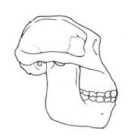 By
two to 2.5 million years ago, the robust
Australopithecines, A. boisei and A robustus, had evolved
away from the human line toward a very heavy build with relatively long
arms. Individuals stood 1.2 to 1.4m and had a cranial capacity of 410
to 530ml. Features included a prominent crest on top of the skull, a long,
broad, flattish face, facial buttressing, and very thick jaws with small
incisors and canines and very large molars. By
two to 2.5 million years ago, the robust
Australopithecines, A. boisei and A robustus, had evolved
away from the human line toward a very heavy build with relatively long
arms. Individuals stood 1.2 to 1.4m and had a cranial capacity of 410
to 530ml. Features included a prominent crest on top of the skull, a long,
broad, flattish face, facial buttressing, and very thick jaws with small
incisors and canines and very large molars. |
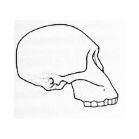 Our
line, the genus Homo, evolved away from robust bodies and skulls
and towards greater cranial capacity and smaller teeth. Homo habilis,
the earliest known Homo, evolved around 2.4 million years ago.
The few known H. habilis fossils show much variability in morphology,
leading some anthropologists to suggest that these fossils represent two
different species. Our
line, the genus Homo, evolved away from robust bodies and skulls
and towards greater cranial capacity and smaller teeth. Homo habilis,
the earliest known Homo, evolved around 2.4 million years ago.
The few known H. habilis fossils show much variability in morphology,
leading some anthropologists to suggest that these fossils represent two
different species. |
 Closer
to us in the lineage is H. erectus,
which evolved around 1.8 million years ago. H. erectus had a robust
but human-like skeleton, stood 1.3 to 1.5m, and had a cranial capacity
of 750 to 1250ml. Features included a flat, thick skull with large occipital
and brow ridge, a robust jaw in larger individuals, and smaller teeth
than H. habilis. Closer
to us in the lineage is H. erectus,
which evolved around 1.8 million years ago. H. erectus had a robust
but human-like skeleton, stood 1.3 to 1.5m, and had a cranial capacity
of 750 to 1250ml. Features included a flat, thick skull with large occipital
and brow ridge, a robust jaw in larger individuals, and smaller teeth
than H. habilis. |
 By
about 120,000 years ago, H. neanderthalensis
or Neandertal (pronounced Neanderthal) had evolved. Although probably
not in our direct line, Neandertals were highly evolved humans who were
well adapted for the harsh conditions of the European Ice Age. They were
robust, large bodied individuals who stood 1.5 to 1.7m and had a cranial
capacity of 1200 to 1750ml. Features included a reduced brow ridge and
thinner skull than earlier Homo, a large nose, midface projection,
and large front teeth. Neandertals survived until around 30,000 years
ago when it is possible that they were out-competed or partially assimilated
by early modern H. sapiens. By
about 120,000 years ago, H. neanderthalensis
or Neandertal (pronounced Neanderthal) had evolved. Although probably
not in our direct line, Neandertals were highly evolved humans who were
well adapted for the harsh conditions of the European Ice Age. They were
robust, large bodied individuals who stood 1.5 to 1.7m and had a cranial
capacity of 1200 to 1750ml. Features included a reduced brow ridge and
thinner skull than earlier Homo, a large nose, midface projection,
and large front teeth. Neandertals survived until around 30,000 years
ago when it is possible that they were out-competed or partially assimilated
by early modern H. sapiens. |
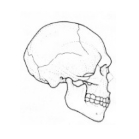 Early
modern H. sapiens, our species, evolved
around 130,000 years ago. Individuals stood 1.6 to 1.85m, had a cranial
capacity of 1200-1700ml, and exhibited skeletal characteristics that we
still share today including a small or nonexistent brow ridge, a short,
high skull, and a developed chin. Early
modern H. sapiens, our species, evolved
around 130,000 years ago. Individuals stood 1.6 to 1.85m, had a cranial
capacity of 1200-1700ml, and exhibited skeletal characteristics that we
still share today including a small or nonexistent brow ridge, a short,
high skull, and a developed chin. |
|
Exercise: 1. Describe the primary evolutionary trends in skeletal morphology of the genus Homo; focusing on H. erectus, H. Neanderthalensis, and H. sapiens. Note particularly the changes to the skull. 2. Like the robust Australopithecines, Neandertals had a skeleton that was more sturdy and rugged than that of H. erectus. But Neandertal is considered to be much more closely related to H. erectus than the robust Australopithecines. Based on morphological characteristics, explain why. 3. A. afarensis is generally considered to be the ancestor of both the robust Australopithecines and Homo. What are some morphological characteristics that support this theory? 4. Notice the variable position of A. africanus in the different phylogenies and decide where you think it belongs. Note there is no right or wrong answer, however you must justify your decision with morphological evidence. |
| *Illustrations are modified from The Cambridge Encyclopedia of Human Evolution, eds. Jones et al. Cambridge University Press, 1992 and Introduction to Physical Anthropology, Seventh Edition, Jurmain et al. Wadsworth Publishing Co., 1997. |